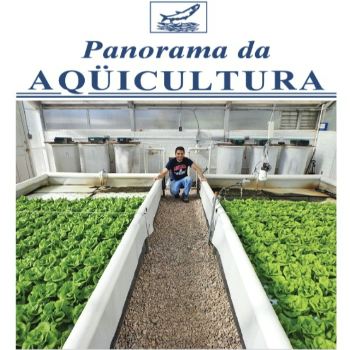|

Photo courtesy from Panorama da Aquiculture Magazine
Would aquaponics be a way to make RAS viable in Brazil?
 BRAZIL
BRAZIL
Tuesday, March 28, 2023, 07:00 (GMT + 9)
Panorama da Aquiculture Magazine continues with the challenge of understanding the evolution of commercial aquaponics in Brazil and in the world and in the search for elements that guide the academy and the productive sector on the perspectives that open up in this theme for the future.
There are many particularities (regional, cultural, social, environmental, political, market, economic, technical, …) that can interfere with the development of commercial aquaponics and we need to stay well informed to understand this dynamic and foresee the opportunities that are to come. In the article of this issue, Prof. Brunno Cerozi from ESALQ/USP brings a very sensible approach to values involved in the production cost of aquaponics and the subsystems that compose it, recirculating fish farming and hydroponics, and advances in the demystification of aquaponics.
First Aquaponics Experiments at the Environmental Research Lab at the University of Arizona | (Credit: Dr. Kevin Fitzsimmons)
Therefore, even if at a less frenetic pace, it is a fact that world aquaculture continues to grow. While the proliferation of aquaculture ventures around the world has generated excitement, there is also a discussion about the possible environmental impact of nutrient-rich effluents generated by fish farming. The general public began to understand the origin of the fish on their plates and began to question where so much water comes from and where so much “manure” goes when so much fish is raised in confinement. There have even been waves of misinformation that come and go, from time to time, questioning the quality of fish coming from aquaculture, placing captured fish in the status of a noble product.
Current model of fish farming in net cages with exploitation of ecosystem services to provide water and oxygen, and treatment of nitrogen, phosphorus and organic carbon
Certainly, in the last two decades, the growing concerns about the excessive discharge of nitrogen and phosphorus into water bodies resulted in several studies with the objective of better understanding the issues related to the generation of effluents by aquaculture production. Regulations that require the reduction of the impact of effluents rich in nitrogen and phosphorus from aquaculture facilities have become increasingly restrictive, which may affect the financial sustainability and viability of future fish farms and those in operation. The establishment of global nitrogen and phosphorus disposal standards has been widely discussed to facilitate the implementation of fish farming systems that reduce eutrophication risks and other environmental concerns, while providing income and social benefits.
Booster tank with motor pump set and aerator tube (left) and tilapia production tanks (right) - Courtesy of Panorama da Aquiculture Magazine
In recent years, fish farming has become increasingly integrated into a broader agricultural context. Systems that incorporate fish farming into agriculture are being progressively recognized as environmentally sustainable practices that, by combining the production of aquatic and terrestrial species, promote the multiple use of water and recycling of waste generated by fish farming. In a system with several integrated sub-components, waste from one sub-component can be recycled to become inputs for other sub-components. As a result, the productivity of the business as a whole is increased through the efficient use of resources, reducing nutrient and water losses from the system, in addition to diluting the financial risk by diversifying the supply of several products instead of just one. (continues...)
Author/Source: Paulo Carneiro – Embrapa Coastal Tablelands/ Panorama da Aquiculture Magazine (translated from original in portuguese) | read the full article here
|
|



